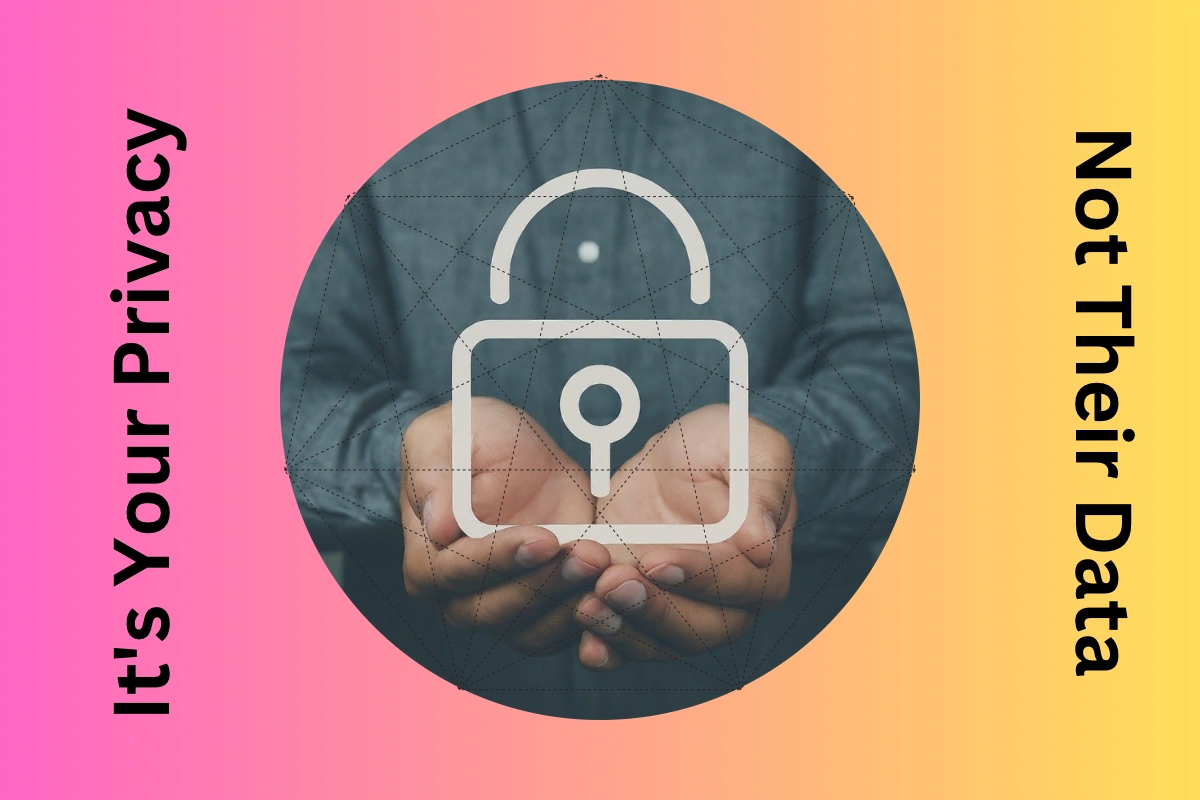Are We Losing the Fight for Our Digital Selves?
Ever feel like your online life is being dissected, categorized… even stolen?
I have seen it. And I’ve discovered that AI, while extraordinary, has quietly rewritten the rules of privacy.
It doesn’t just watch what you post. It watches how you scroll, how long you linger, even your face. From photos. From videos. From biometric breadcrumbs you didn’t know you left behind.
That’s why we advocate for ethical frameworks in every campaign — because real privacy starts with real strategy. We safeguard our clients’ privacy with strategic social media management. The Washington Post recently confirmed that even apps you don’t actively use, like Facebook or Instagram, can collect browsing data via hidden tracking pix
What it builds from that is chilling:
- Hyper-detailed digital profiles that become a goldmine for anyone with bad intentions.
- Deepfakes and voice clones using your own likeness to commit fraud or extort your family.
- AI-generated scams, personalized to manipulate you.
- Synthetic identities — a Frankenstein version of you made from hacked details, that can open accounts, apply for loans, and disappear.
Some of it, powered by the very platforms we “agreed” to.
And here’s the kicker: most of us have no idea how to stop it.
Terms of service are designed to confuse. Deleting your data feels impossible. And the damage? It’s not just personal — it’s reputational. It’s liability.
Which raises a chilling question:
If trust is our currency online, how much are we losing without realizing it?
Or Is AI Our Digital Guardian?
But here’s the flip side — the part that gives me hope.
AI isn’t just part of the problem. It’s also part of the solution.
When built with privacy and accountability in mind, AI can move faster than threats, detect patterns humans miss, and quietly reinforce the digital locks we often forget we need.
So, can AI stop bad actors before they strike? Yes, and it’s already happening.
Defensive Uses of AI
- Anomalies and Alerts: AI flags unusual login attempts, location mismatches, and sudden spikes in followers, all signs of compromised or synthetic accounts.
- Impersonation Defense: AI scans for cloned profiles, spam bots, and identity misuse, blocking them before damage is done.
- Smarter Authentication: From how you type to how your face moves — AI-enabled biometrics are adding layers of friction for fraudsters, not users.
And the best part? AI doesn’t have to see everything to keep us safe.
New techniques let AI do more with less data:
- Differential Privacy: Adds noise to mask your individual info while still learning from the crowd.
- Federated Learning: Trains AI right on your device — your data never leaves home.
- Homomorphic Encryption: Enables analysis while your data stays encrypted. (Yes, really.)
- Synthetic Data: Fake-but-useful data for training models, with zero personal risk.
What about regulations?
AI can automate GDPR compliance, manage consent tracking, and enforce deletion timelines — helping platforms meet privacy standards before audits or breaches occur. Compliance isn’t just about checking boxes, it’s about safeguarding dignity in every interaction. Countries are introducing stronger protections like the GDPR and California CCPA.
Does it actually help us feel safer online?
Done right, yes. Think:
- Real-time alerts for suspicious activity
- Streamlined privacy dashboards
- Fewer breaches, less guesswork
In the right hands, AI doesn’t just predict problems. It prevents them. But for AI to truly protect us, it has to be designed with us — not just about us — from the very start.

The Hybrid Future: "Responsible AI Privacy by Design"
So, where do we land?
It’s clear: AI is a double-edged sword. The path forward isn’t about rejecting it. It’s about building it intentionally, with privacy, ethics, and human well-being at the core.
That’s what “Responsible AI Privacy by Design” means. Not reactive measures after a breach — but systems built from the ground up to protect people, reputations, and rights.
What would that actually look like?
- Privacy by Default: AI tools should only collect what’s necessary, no more, no less. Give people clear choices, not buried settings. Outdated data? Gone automatically.
- Clarity, Not Complexity: No more legalese. Everyone should be able to see what AI is doing with their data, and decide whether that’s okay. If you can’t opt out, it’s not real consent.
- Stronger Rules, Real Enforcement: Governments must treat AI and biometric data like what they are: high-risk. That means regulating deepfakes, protecting facial data, and imposing penalties that actually deter bad actors.
- Cross-Industry Collaboration: The fight against fraud isn’t one platform’s job. Social media companies, cybersecurity experts, AI researchers, and yes, even legal and compliance professionals, need to share tools, standards, and threat intel.
- User Education as a Frontline Defense:: Strong passwords and two-factor authentication still matter. But so does digital literacy: knowing when something feels off, limiting what we post publicly, and understanding our rights online.
- Purpose Over Profit: It’s time to reframe the mission. AI should exist to protect, not manipulate. Let it help detect fraud, enforce policies, and empower users, not just drive engagement.
Clear, respectful communication builds trust — and that starts with the content itself. For best practices, consider storytelling in branding that respects privacy. Even privacy-conscious privacy-conscious email subject lines matter. New data shows 63.9% of the world uses social media daily, meaning these messages land in front of real, global audiences.
So what’s the bigger picture?
I believe in Human-Centric AI Governance — where AI is always aligned with ethics, accountability, and public interest. That means:
- Auditable Systems: We deserve to know how decisions are made. No more black-box algorithms.
- Bias Protection: AI must be trained, and monitored, to prevent discrimination, especially when used in hiring, insurance, or access to services.
- True Digital Sovereignty: Your digital identity should be something you own, not something platforms rent. You should be able to manage, limit, or revoke access to your data with confidence.
But even if AI plays by the rules, how do we prove we are who we say we are — without handing over more than we should?
Can Blockchain or Retina Scanning Fix Online Authentication?
When it comes to verifying identity online, we’re in a strange paradox: the more we try to prove we are who we say we are, the more vulnerable we can become. That’s why new technologies like blockchain and retinal biometrics are getting serious attention — not just as gimmicks, but as potential safeguards for our digital autonomy.
Blockchain for Identity - The Rise of Self-Sovereign Identity (SSI)
What if your identity wasn’t stored in one place, but everywhere and nowhere, all at once?
That’s the idea behind Self-Sovereign Identity, or SSI. Built on blockchain technology, it shifts control away from central platforms and back to the individual.
- Decentralized = Less RiskDecentralized, verifiable credentials
- Tamper-Proof by Design: Once recorded, your credentials can’t be silently altered or erased. Think of it as a fraud-proof audit trail.
- Private by Default: Encryption protects your identity. You hold the private keys, not a company, which eliminates password vulnerabilities.
- Selective Disclosure: Need to verify your age? Share that, without revealing your full birthdate. It’s permissioned access, not an all-access pass.
- Verifiable Credentials: Picture a secure, digital version of your ID or medical license in a private wallet. Instantly verifiable, never stored by the platform asking for it.
- Global Accessibility: This could extend secure identity to the billions without traditional documents — transforming legal, health, and financial access.
But it’s not all seamless yet
- Speed at Scale: Blockchains struggle with high-volume identity checks (for now).
- Mass Adoption Needed: Tech is ready, but global systems, from governments to service providers, are slow to align.
- Right to Be Forgotten?Blockchain is immutable. Privacy laws say your data should be erasable. The compromise? Store sensitive info off-chain, with encrypted proofs on-chain.
- Cost: Implementation isn’t cheap, especially for smaller organizations.
Retina Scanning: Biometrics at the Next Level
If passwords can be guessed and fingerprints can be lifted, retinal biometrics go several steps further.
- Virtually Unspoofable: Your retina’s vascular pattern is unique, even identical twins don’t share it. It’s incredibly difficult to fake.
- Physically Secure: Unlike facial features, your retina is internal. It can’t be scanned without your presence.
- Already in Use: High-security labs, military zones, even some ATMs use this tech, not because it’s trendy, but because it works.
- Challenges?Sure. Devices are expensive. Privacy fears linger. And any biometric data, no matter how secure, must be stored and transmitted with strict safeguards.
But while these technologies promise airtight protection, can they actually keep pace with the messy, fast-moving world of social media?
Frequently Asked Social Media Privacy Questions
Longer answer: Most platforms let you choose who sees your posts, but once something’s online, it’s hard to erase completely. Think of it like splashing paint — you can’t really un-mix it once it’s on the wall.
- Data breaches: Your info can be stolen or leaked.
- Targeted ads: You’re tracked and profiled in unsettling detail.
- Cyberbullying: Sadly, it’s common — especially in public threads.
- Mental health toll: The pressure of always being “on” is real.
- Lack of control: Your content and data can be reshared without your okay.

